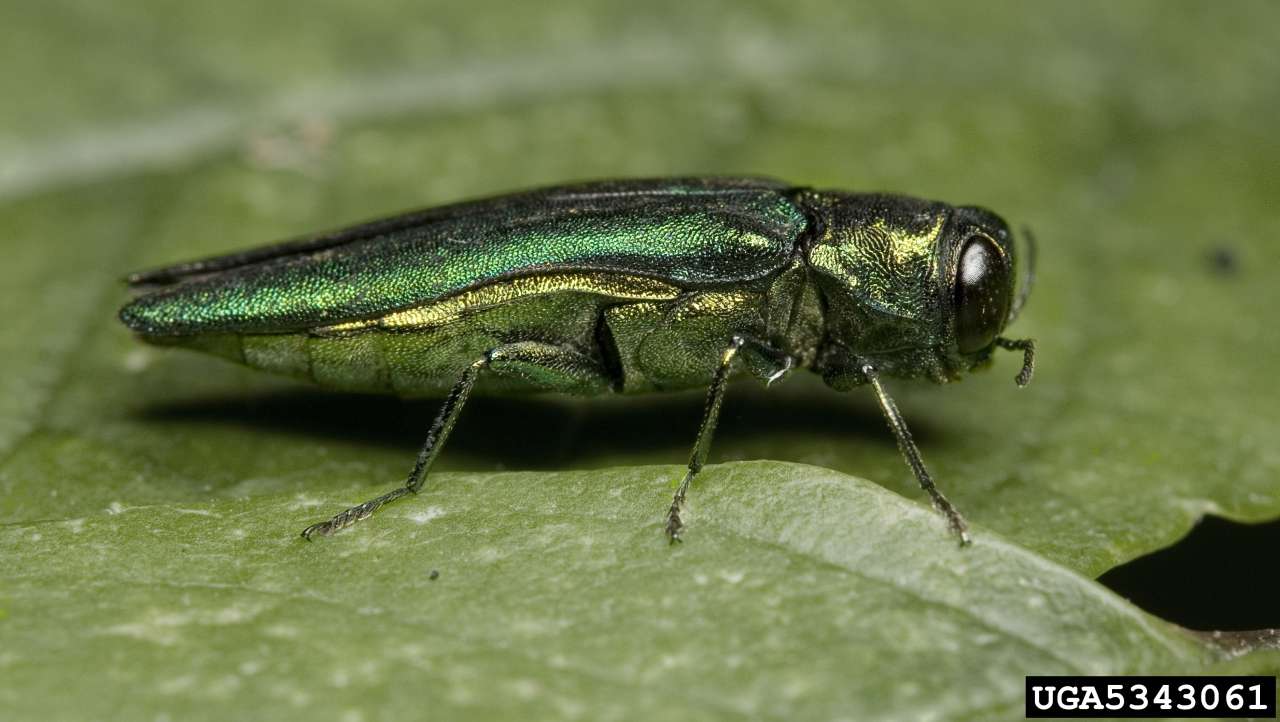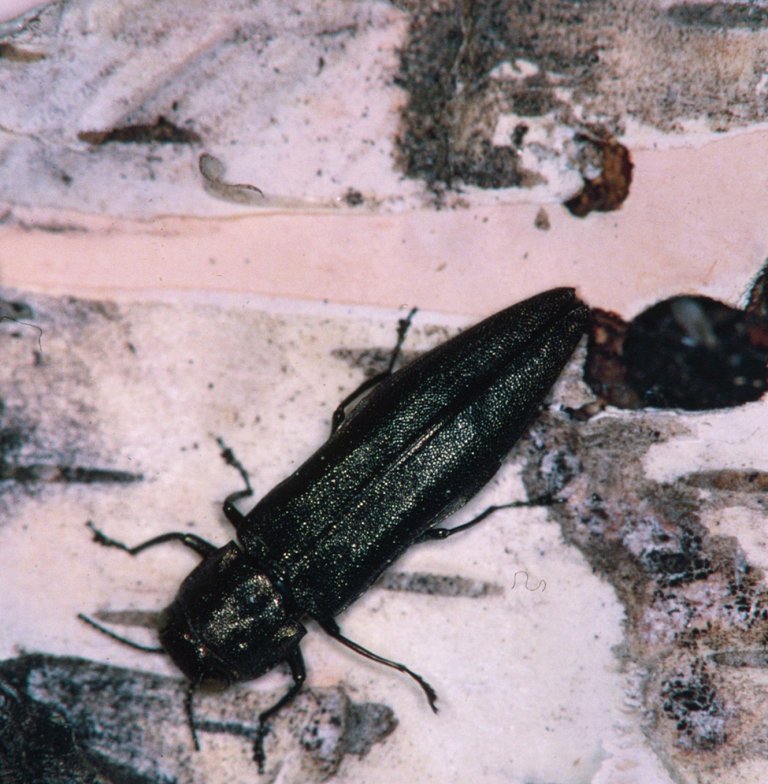Invaderende insekter

Asiatisk askepraktbille (Agrilus planipennis).
Foto: David Cappaert, Michigan State University, Bugwood.org
Insekter som introduseres til nye områder kan gi omfattende tredød og store endringer i skogøkosystemer. Erfaringer fra andre deler av verden viser tydelig det store skadepotensialet til fremmede invaderende arter.
Truende praktbiller
Det norrøne verdenstreet ask er utsatt for harde angrep av fremmede skadegjørere både i Europa og Nord-Amerika. Asiatisk askepraktbille («emerald ash borer», Agrilus planipennis) ble introdusert i USA med importvirke i 2002. I dag er den spredd i 35 amerikanske stater og fem tilstøtende provinser i Canada. Der har den drept enorme arealer med askeskog, og skadeomfanget er anslått til over 14 milliarder kroner i året. Etter flere mislykkete kampanjer snakker ikke amerikanerne lenger om å utrydde arten. Askepraktbillen kan spres over store avstander med flisimport, og simuleringsforsøk utført ved NIBIO viser at flisstørrelsen må være svært liten dersom arten ikke skal kunne overleve i importert flis. Arten er også introdusert rundt Moskva, og videre spredning vestover mot resten av Europa er sannsynlig.
Bjørk i 11 tidssoner kan være truet om amerikansk bjørkepraktbille (Agrilus anxius) skulle bli innført i Europa og Asia. Arten er vidt utbredt i Nord-Amerika og gjør skade på amerikanske bjørkearter i tørkeår, men den har så langt ikke blitt etablert på vårt kontinent. Forsøk med plantinger av våre vanligste bjørkearter i USA viser at disse har 100 % dødelighet etter angrep av amerikansk bjørkepraktbille, og det samme gjelder asiatiske bjørkearter. Bjørkepraktbillen er mindre enn asiatisk askepraktbille og kan trolig overleve i svært små treflis av bjørk.
Sultne biller fra vest
Ulike barkbillearter har drept enorme mengder barskog i Nord-Amerika de siste tiårene. I Canada har «mountain pine beetle» (Dendroctonus ponderosae) hatt tidenes kraftigste barkbilleutbrudd. I løpet av en tiårsperiode har denne billen drept 725 millioner kubikkmeter furu – et volum som tilsvarer mer enn 70 ganger den årlige hogsten i Norge. «Mountain pine beetle» kan også angripe vår hjemlige furu. Andre nord-amerikanske barkbillearter kan true vår egen gran. Simuleringsstudier tyder på at slike nye arter kan føre til økt tredreping om de opptrer sammen med vår egen granbarkbille.
Føre var eller etter snar?
Hvordan man best skal håndtere fremmede arter avhenger i stor grad av hvor langt en introduksjon har kommet. Det er svært vanskelig og kostbart å utrydde en art som har rukket å etablere seg, og det finnes knapt eksempler på at slike utryddelseskampanjer har vært vellykkete. For arter som allerede er etablert vil det derfor gjerne være et spørsmål om å bremse spredningen mest mulig. Overvåking av importerte varer for å hindre innførsel av fremmede arter byr i mange tilfeller på store praktiske utfordringer. Vi har studert prøvetaking etter viktige skadegjørere i importerte tømmer- og trevarer. Resultatene var nedslående og viste at prøvemengden som er nødvendig for sikker påvisning oftest er urealistisk store.
Det sikreste tiltaket mot fremmede arter er å sørge for at de ikke ankommer norsk territorium overhodet. Dette kan medføre at bestemte varer enten ikke kan importeres i det hele tatt fra områder der artene finnes, eller må behandles slik at artene med sikkerhet ikke følger med. Slike reguleringer krever risikovurderinger som er utarbeidet etter internasjonale retningslinjer og basert på grundig biologisk grunnarbeid.
KONTAKTPERSON

Bjørn Økland
Seniorforsker
-
Divisjon for bioteknologi og plantehelse
(+47) 916 28 225 bjorn.okland@nibio.no Kontorsted: Ås - Bygg H8

Paal Krokene
Seniorforsker
-
Divisjon for bioteknologi og plantehelse
(+47) 995 16 013 paal.krokene@nibio.no Kontorsted: Ås - Bygg H8

KONTAKTPERSON

Bjørn Økland
Seniorforsker
-
Divisjon for bioteknologi og plantehelse
(+47) 916 28 225 bjorn.okland@nibio.no Kontorsted: Ås - Bygg H8

Paal Krokene
Seniorforsker
-
Divisjon for bioteknologi og plantehelse
(+47) 995 16 013 paal.krokene@nibio.no Kontorsted: Ås - Bygg H8
Publikasjoner
Sammendrag
submittedVersion
Sammendrag
Det er ikke registrert sammendrag
Sammendrag
Increasing inter-continental trade with wood chips represents a challenge for phytosanitary authorities, as such trade may lead to pest introductions and invasions with huge impacts on forest ecosystems and economy. Predicting species invasions and their impacts in advance may be difficult, but improved information about potential invasive species ahead of any interceptions is an important precautionary step to reduce the probability of invasions. Here we identify bark- and wood-boring insects that have a potential to become invasive in northern Europe, and that may be introduced by import of deciduous wood chips from North America. The potentially most damaging species belong to the beetle genus Agrilus (Buprestidae), which includes the highly damaging emerald ash borer A. planipennis. We give a brief presentation of this and seven other Agrilus species or subspecies, and review factors of importance for the risk of establishment and potential economic and ecological impacts of these species. We also discuss one Scolytinae, Hylurgopinus rufipes. There are strong indications in the literature that some north European trees are highly susceptible to attack from the selected beetle species. We therefore conclude that because north European trees have not coevolved with these herbivores and thus may lack adequate defenses, most of the identified beetle species are likely to spread in “defense- and enemy-free space” if they are introduced to northern Europe, with considerable economic and ecological consequences.
Sammendrag
Increasing inter-continental trade of wood chips for biofuel represents a significant risk of introducing invasive pest species that can cause biome-scale impacts on forest ecosystems. Some potentially invasive species have the capacity to cause high tree mortality on the Eurasian continent and could cause significant impacts on biodiversity and ecosystem functions. Because eradication of established species is difficult, there is a need for scientific studies that can evaluate the reliability of current import control practices to ensure lowest possible risk of establishment of potentially harmful species. We used a stochastic simulation model and sensitivity analyses to evaluate the chance of detecting harmful pests in imported wood chips by sampling according to the current use of internationally accepted standards. As an example, we focused on the North American beetle Agrilus anxius (bronze birch borer) that can cause 100% mortality of European and Asian birch species in North America. We simulated the process from logging in North America to sampling the wood chips upon arrival in Europe. The probability of pest detection for current sampling protocols used by port inspectors was very low (<0.00005), while a 90% chance of detection may require sampling 27 million litres of wood chips per shipload.
Sammendrag
Frequent bark beetle outbreaks cause biome-scale impacts in boreal and temperate forests worldwide. Despite frequent interceptions at ports of entry, the most aggressive bark beetle species of Ips and Dendroctonus in North America and Eurasia have failed to establish outside their original home continents. Our experiments showed that Ips typographus can breed in six North American spruce species: Engelmann spruce, white spruce¸ Sitka spruce, Lutz spruce, black spruce and red spruce. This suggests that differences between the Eurasian historical host and North American spruce species are not an insurmountable barrier to establishment of this tree-killing species in North America. However, slightly diminished quality of offspring beetles emerged from the North American spruces could reduce the chance of establishment through an Allee effect. The probabilistic nature of invasion dynamics suggests that successful establishments can occur when the import practice allows frequent arrivals of non-indigenous bark beetles (increased propagule load). Model simulations of hypothetical interactions of Dendroctonus rufipennis and I. typographus indicated that inter-species facilitations could result in more frequent and severe outbreaks than those caused by I. typographus alone. The potential effects of such new dynamics on coniferous ecosystems may be dramatic and extensive, including major shifts in forest structure and species composition, increased carbon emissions and stream flow, direct and indirect impacts on wildlife and invertebrate communities, and loss of biodiversity.
Sammendrag
Det er ikke registrert sammendrag
